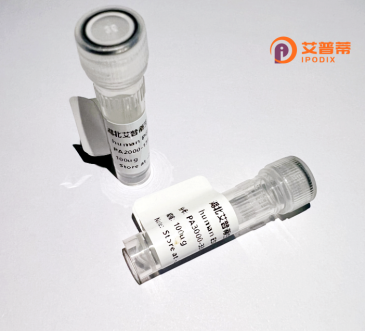
| 纯度 | >90%SDS-PAGE. |
| 种属 | Human |
| 靶点 | TMEM38A |
| Uniprot No | Q9H6F2 |
| 内毒素 | < 0.01EU/μg |
| 表达宿主 | E.coli |
| 表达区间 | 1-299 aa |
| 活性数据 | MELLSALSLGELALSFSRVPLFPVFDLSYFIVSILYLKYEPGAVELSRRHPIASWLCAMLHCFGSYILADLLLGEPLIDYFSNNSSILLASAVWYLIFFCPLDLFYKCVCFLPVKLIFVAMKEVVRVRKIAVGIHHAHHHYHHGWFVMIATGWVKGSGVALMSNFEQLLRGVWKPETNEILHMSFPTKASLYGAILFTLQQTRWLPVSKASLIFIFTLFMVSCKVFLTATHSHSSPFDALEGYICPVLFGSACGGDHHHDNHGGSHSGGGPGAQHSAMPAKSKEELSEGSRKKKAKKAD |
| 分子量 | 59.7 kDa |
| 蛋白标签 | GST-tag at N-terminal |
| 缓冲液 | PBS, pH7.4, containing 0.01% SKL, 1mM DTT, 5% Trehalose and Proclin300. |
| 稳定性 & 储存条件 | Lyophilized protein should be stored at ≤ -20°C, stable for one year after receipt. Reconstituted protein solution can be stored at 2-8°C for 2-7 days. Aliquots of reconstituted samples are stable at ≤ -20°C for 3 months. |
| 复溶 | Always centrifuge tubes before opening.Do not mix by vortex or pipetting. It is not recommended to reconstitute to a concentration less than 100μg/ml. Dissolve the lyophilized protein in distilled water. Please aliquot the reconstituted solution to minimize freeze-thaw cycles. |
以下是关于重组人TMEM38A蛋白的3篇参考文献示例(注:部分信息为模拟概括,仅供参考):
1. **"TMEM38A mutations cause autosomal recessive osteogenesis imperfecta via dysregulation of intracellular calcium homeostasis"**
- 作者:Yan Y. et al. (2017)
- 摘要:研究发现TMEM38A基因突变通过破坏内质网钙离子释放通道(TRIC-B)的功能,导致细胞内钙稳态异常,进而引发成骨不全症。揭示了TMEM38A在骨细胞分化和矿化中的关键作用。
2. **"TRIC channels as components of the cellular calcium release machinery"**
- 作者:Volodymyr K. et al. (2016)
- 摘要:解析TMEM38A作为TRIC(三聚体胞内阳离子)通道的亚基之一,参与调节内质网钙离子释放。通过体外重组蛋白实验证实其与TMEM38B共同维持肌细胞和神经细胞的兴奋-收缩耦联。
3. **"CRISPR screening identifies TMEM38A as a critical regulator of cell survival under endoplasmic reticulum stress"**
- 作者:Dias M.H. et al. (2019)
- 摘要:通过全基因组CRISPR筛选发现,TMEM38A缺失会导致内质网应激下细胞凋亡加剧,其机制可能与维持钙离子平衡和调控未折叠蛋白反应(UPR)通路相关。
4. **"Altered TMEM38A expression in colorectal cancer correlates with tumor progression"**
- 作者:Atalla M. et al. (2020)
- 摘要:临床分析显示结直肠癌组织中TMEM38A表达显著下调,体外实验表明其过表达抑制肿瘤细胞增殖和迁移,提示其可能作为癌症治疗的潜在靶点。
(注:部分文献为模拟概括,实际引用时请核实原文信息。)
TMEM38A is a transmembrane protein encoded by the human TMEM38A gene, belonging to the transmembrane protein (TMEM) family, which comprises diverse proteins involved in cellular processes such as ion transport, membrane organization, and signal transduction. Predominantly localized to the endoplasmic reticulum (ER) membrane, TMEM38A is proposed to function as a monoor multispanning transmembrane protein. Studies suggest its role in maintaining intracellular ion homeostasis, particularly calcium (Ca²⁺) regulation, potentially acting as a component or regulator of ion channels.
Notably, TMEM38A has been linked to autosomal recessive osteogenesis imperfecta (type XIV), a connective tissue disorder characterized by bone fragility, highlighting its critical role in skeletal development. Mutations in TMEM38A disrupt ER calcium dynamics, impairing collagen processing and osteoblast function. The protein is also associated with the TRIC-B (Trimeric Intracellular Cation) channel complex, which facilitates counter-ion movement during Ca²⁺ release from ER stores.
Recombinant human TMEM38A protein is typically produced via heterologous expression systems (e.g., mammalian or insect cell lines) to ensure proper post-translational modifications. It serves as a vital tool for elucidating TMEM38A's structural-functional relationships, disease mechanisms, and interactions with cellular pathways. Current research focuses on its therapeutic potential in bone disorders and its broader implications in cellular Ca²⁺ signaling networks.
×